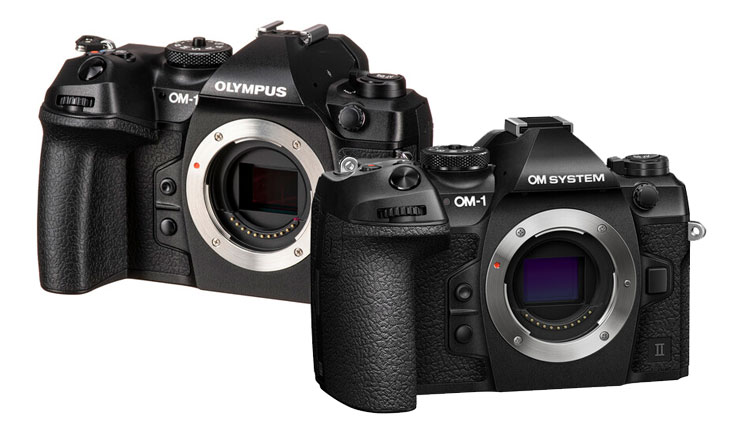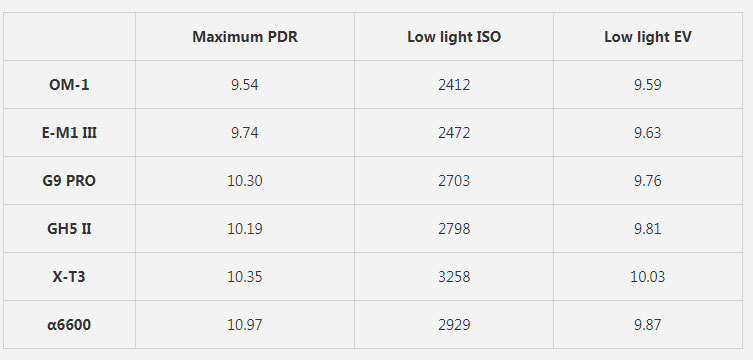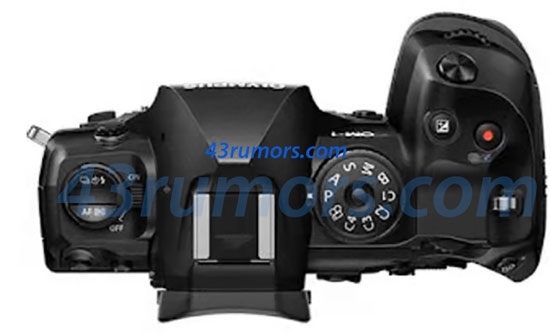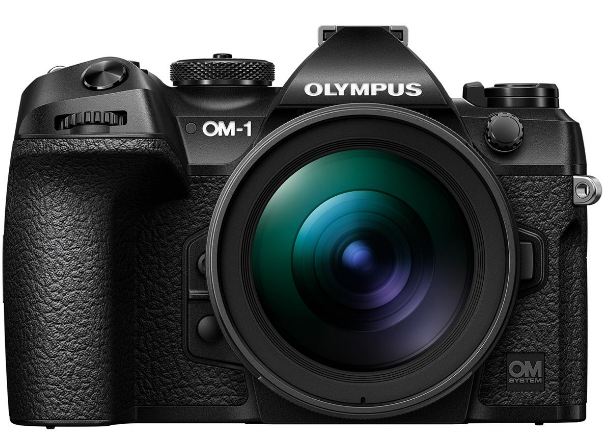
Finally, we have the Oly OM-1 Camera, the camera features a 20.4MP Micro Four Thirds Stacked CMOS sensor powered by a TruePic X Dual Quad Core Processor. The sensor features four photodiodes at each pixel position, allowing each pixel to contribute to X-type phase detection autofocus.
Olympus OM-1 Major SPecification
- OM-1 Mirrorless Digital Camera Highlights
- 120 Frames Per Second Continuous Shooting
- 8.0 EV Stops of Stabilization Performance
- 80MP High Res Shot Mode
- M.Zuiko ED 12-40mm f/2.8 PRO II Highlights
- F2.8 Bright Aperture
- IP53 Weather sealed Performance
- 24 – 80mm 35mm Equivalent Focal Length
- Sensor Size: Micro Four Thirds Format
- Resolution: 20 MP
- Max Video Quality: 4K 60fps
- Lens Included: 12-40mm
- In-Body Stabilization: 5-Axis Digital
- Configuration: Body & Lens
- WiFi: Yes
- Edition: Standard
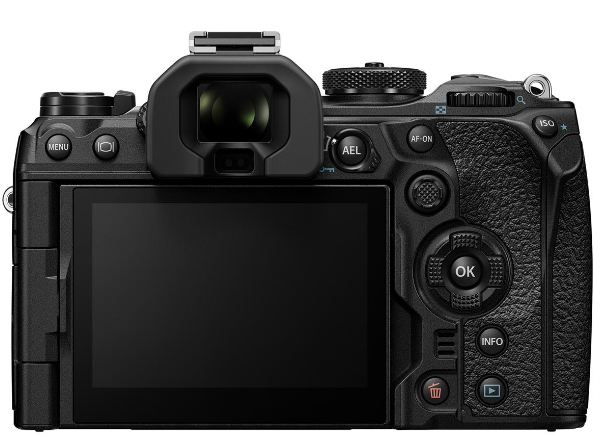
The mechanical shutter is limited to 10 frames per second (fps) with its mechanical shutter, but this jumps to 120 fps (blackout-free) using the electronic shutter, with support for autofocus and auto-exposure up to 50 fps.
Olympus OM-1 Video Specification
4K video (UHD or DCI) at up to 60 fps and Full HD (1080p) video at up to 240 fps. Internally, the camera can record 10-bit video internally. OM-1 can output a Raw 12-bit 4:4:4 video on external recorders.
OM-1 can output a Raw 12-bit 4:4:4 video on external recorders.
Did you get that? and the camera is weather-sealed without any cooling fan inside it with 8 stops of IBIS unit (sensor floating in air still camera manages to record 12 bit 4:4:4 videos without heat warning ) … amazing isn’t it?
The ‘Cross Quad Pixel AF’ system gives 1,053 cross-type phase detection AF points, which work to drive the OM-1’s AI-trained autofocus modes for ‘formula cars, motorcycles, airplanes, helicopters, trains, and birds, as well as animals (dogs and cats).’ Below is a demonstration of the animal eye autofocus system working with a dog
Pricing and Availability
OM SYSTEM OM-1 (Body Only)
Pricing: $2,199.99 USD; $2,799.99 CAD
Approximate Availability date: Early March 2022
OM SYSTEM OM-1 Kit with M.Zuiko Digital ED 12-40mm F2.8 PRO II
Pricing: $2,799.99 USD; $3,599.99 CAD
Approximate Availability date: Early March 2022
Separately Available Accessories
Olympus OM-1 Press Release
The New OM SYSTEM Flagship Model Revolutionizes Emerging Technology and Newly Developed Devices
Bethlehem, PA, February 15, 2022 – OM Digital Solutions is pleased to announce the introduction of the OM SYSTEM OM-1: This Micro Four Thirds System standard interchangeable lens camera features a compact, lightweight design for superior mobility along with high image quality. It is scheduled to go on sale in early March 2022. As the OM SYSTEM flagship camera, this model will deliver a one-of-a-kind experience to customers, driving the desire for photographers to create. This interchangeable lens camera delivers inspiration in a lightweight design that users can take along anywhere to capture the precise photos they have in mind.
The OM SYSTEM OM-1 is the culmination of new devices and cutting-edge digital technologies, delivering high image quality that goes beyond the expectation of the sensor size. It also features autofocus and sequential shooting performance that far surpasses conventional models, and dramatically improves basic performance. Computational photography technology has been incorporated, empowering the photographer to utilize such features as Live Composite and High Res Shot mode, without the need for advanced shooting techniques, special equipment, or skills, delivering a rich variety of expressive power for more photographic opportunities than ever before.
Thanks to the superb mobility of the Micro Four Thirds system, the OM SYSTEM OM-1 can be taken anywhere at any time, allowing anyone to take advantage of its high performance to capture versatile images with high image quality. This is the next generation Micro Four Thirds camera brought to you by OM SYSTEM.
MAIN FEATURES:
1. High image quality that goes beyond the expectations of the sensor size
This model features a high-end compact, lightweight body unique to OM SYSTEM, including the new 20 Megapixel1 Stacked BSI Live MOS sensor, and the latest TruePic X image processor, which is three times faster than previous models. The OM SYSTEM OM-1 delivers high image quality that goes beyond the expectations of the sensor size. Not only does it take full advantage of high-resolution M.Zuiko Digital lens performance, delivering our highest ever resolution2, but new noise processing technology increases the maximum normal sensitivity to ISO 25600, and an expanded maximum sensitivity to ISO 102400. Furthermore, the dynamic range has been improved thanks to the latest image processing technology. These improvements deliver a richer range of tonal expressions than ever before, from shadows to highlights.
The high-performance image stabilization in the OM SYSTEM OM-1 delivers up to 8.0 steps3 of compensation with 5-axis sync IS, and up to 7 steps4 with the body alone. The new Handheld Assist feature makes it easy to capture slow shutter speed effects that previously required a tripod.
2. Computational photography functions that empower the photographer to further expand their imaging expressions
Photographic expressions that have traditionally required special equipment and a computer to composite images are available in the OM SYSTEM OM-1. Thanks to computational photography (advanced digital image processing) technology, these imaging features have been incorporated in this interchangeable lens camera at an early stage. The OM SYSTEM OM-1 uses a combination of the new TruePic X image processor, the new image sensor, and the latest digital technologies to make computational photography features better and even easier to use. When paired with high-performance M.Zuiko PRO lenses, the system makes it possible to capture a greater range of imaging expressions only possible with the OM SYSTEM OM-1.
High-Res Shot
The processing time has been significantly reduced. Handheld High-Res Shot mode takes approximately five seconds to merge. Popular for landscape photos due to the ability to capture high-resolution approximately 50 Megapixel images by merging multiple images; and Tripod High-Res Shot, which creates ultra-high-resolution approximately 80 Megapixel images. Composite processing technology reduces noise by approximately two steps for amazingly high pixel count and low noise. A dedicated button is also included on the camera to quickly switch between normal shooting and Handheld High-Res Shot/Tripod High Res Shot for improved usability.
Live ND
Create slow shutter speed effects as though you were using an ND filter up to ND64 (six steps) (ND2 – ND64). When LV Simulation is activated, you can check the slow shutter speed effects in the viewfinder and on the LCD monitor before shooting and create the same effects while using ultra-wide-angle lenses that cannot accommodate an ND filter.
Live Composite
In this setting, Lighten Composite is used to add only the brighter sections to the composite image to prevent the common problem of images that are too bright overall when shooting long exposures, resulting in beautiful photos with plenty of variation. This feature is now compatible with image stabilization and can be used during handheld shooting.
Focus Stacking
This feature alters the focus to capture and composite multiple shots for recording photos that are in focus from the foreground to background. The compositing time has been dramatically reduced for easier use.
HDR Shooting
Multiple images at differing exposures are merged to create one shot with a wide dynamic range, including highlights and shadows.
3. High-speed performance of newly developed autofocus and dramatically improved performance for maximum 50 fps5 sequential shooting with AF/AE tracking
A quad-division photo diode configuration allows for On-chip Phase Detection in both vertical and horizontal directions. 1,053-point, all cross-type, Cross Quad Pixel AF is incorporated; designed to focus on various patterns of subjects across all pixels and the entire shooting range. The high-speed calculation capabilities of the new TruePic X processor and the new AF algorithm enable high-speed, high precision focusing on the subject no matter where it is in the frame. Furthermore, this model is equipped with AI Detection AF,
which was developed using deep learning technology. In addition to greater than ever high-speed, high-precision subject recognition and tracking, this model can recognize formula cars, motorcycles, airplanes, helicopters, trains, and birds, as well as animals (dogs and cats). In addition to C-AF, this functionality is also supported with S-AF for shooting a wider variety of scenes. The detection precision, tracking performance, and responsiveness of Face Priority/Eye Priority AF have been improved significantly.
There have also been exponential improvements to sequential shooting performance, reaching up to 50 fps blackout free AF/AE tracking at approximately 20.37 Megapixel, and up to 120 fps AF/AE locked ultra-high-speed sequential shooting. When using Pro Capture, which is designed for capturing shots that are not possible during normal shooting, you can enjoy sequential shooting up to 50 fps (AF/AE tracking) and up to 120 fps (AF/AE locked).
4. Camera body features enhanced dustproof and splashproof performance, along with a high-speed, high-resolution electronic viewfinder
The dustproof and splashproof performance is achieved by incorporating sealing materials at the appropriate locations on the tough, lightweight magnesium alloy body, ensuring IP53 dustproof and splashproof protection class6, and freezeproof performance to -10°C. Because this model is compact, lightweight, and features dustproof and splashproof performance, it makes for a powerful ally when shooting in punishing environments. The high-performance EVF is equipped with approximately 5.76 million dot resolution, a viewfinder magnification of up to 1.65x, a display delay of 0.005 seconds7, and 120 fps high-speed display, to ensure optimal shooting comfort. Not only does it feature all the best facets of an optical viewfinder, but it also offers the advantages of a digital viewfinder, making it possible to view subjects and check exposure, even in dark locations. The menu screen configuration has been completely redesigned on the OM SYSTEM OM-1. Items have been split, merged, and reclassified, and descriptions have been simplified to make it easier to find the desired functions, and make changing settings simpler for first-time users.
5. Enhanced video functions for creators (10bit 4K 60p, Full HD 240p)
Stable handheld video recording is possible thanks to a compact, lightweight body and industry-leading image stabilization. Creative video functions include 4K 60p for smooth, high-definition videos, and high-speed movie with Full HD videos at a maximum 240p. The camera also supports H.264 (8bit), H.265 (10bit), and Multi Frame Rate for recording video clips over 30 minutes in length. In addition to RAW data output up to 12 bit 4:4:4 to external devices for advanced post-production tasks, the OM SYSTEM OM-1 supports OM-Log for a greater level of freedom over imaging expressions thanks to color grading, which allows users to capture highlights and shadows without overexposing or underexposing shots. The new HLG (Hybrid Log Gamma)8 video picture mode has been added for easier HDR video recording.
Other Features
- Reliable SSWF (Supersonic Wave Filter) dust reduction system that vibrates at a speed of more than 30,000 times per second to instantly remove dirt and dust from the image sensor
- Highly durable shutter unit that clears 400,000 shutter actuations (according to in-house testing conditions)
- Staggered layout UHS-II compatible dual SD card slots make it easier to remove recording media
- Five rating categories in the on-camera rating system
- Night view mode makes it possible to view subjects even in dark environments
- Starry Sky AF makes focusing on stars easier than ever
- Record shooting location information with minimal power drain (smartphone connection)
- Equipped with an independent AEL button and AF-ON button
HLD-10, Power Battery Holder (sold separately)
This power battery holder designed exclusively for the OM SYSTEM OM-1 offers the same controls in the vertical position as the horizontal position. It offers IP53 dustproof and splashproof construction when paired with the OM SYSTEM OM-1. When two BLX-1 Lithium-Ion Rechargeable Batteries in the camera and the HLD-10 are used together, approximately 1,000 shots (based on CIPA tests) can be captured. When attached to the OM SYSTEM OM-1, the BLX-1 Lithium-Ion Rechargeable Battery can be charged9 inside the HLD-10.
Pricing: $349.99 USD; $449.99 CAD
Approximate Availability date: Early March 2022
RM-WR1, Wireless Remote Control (sold separately)
This wireless remote-control features IP5710 dustproof and splashproof construction, enabling remote shooting (communication range: within 5 m of the camera body) in any kind of environment, when paired with the OM SYSTEM OM-1. It enables remote shutter release, control of autofocus, image display control between still images and videos, as well as release lock during long exposures. This power saving design is achieved using Bluetooth® Low Energy communication. It can be used to start and stop video recording and connects with the included cable for wired remote use. The RM-WR1 can also be used as a wired remote control when connected using the cable included with Micro Four Thirds camera models equipped with a compatible remote cable terminal, such as the Olympus OM-D E-M1X and the Olympus OM-D E-M1 Mark III.
Pricing: $99.99 USD; $129.99 CAD
Approximate Availability date: Early March 2022
BLX-1 Lithium-Ion Rechargeable Battery (bundled/sold separately)
This is a high-capacity, 2,280 mAh lithium-ion battery. It can be recharged approximately 500 times.
Pricing: $99.99 USD; $129.99 CAD
Approximate Availability date: Early March 2022
BCX-1 Battery Charger (sold separately)11
This dedicated charger can simultaneously charge two BLX-1 Lithium-Ion Rechargeable Batteries. Batteries are fully charged in approximately 150 minutes. Because the battery is compatible with the USB Power Delivery standard, it can be charged with a power bank (9V/3A output).
Pricing: $149.99 USD; $189.99 CAD
Approximate Availability date: Early March 2022
SBCX-1 Battery Charger (sold separately)
BCX-1 battery charger bundled with one BLX-1 lithium-ion battery.
Pricing: $219.99 USD; $279.99 CAD
Approximate Availability date: Early March 2022
APPLICATIONS/SOFTWARE FOR PHOTOGRAPHY AND EDITING SUPPORT
OM Image Share Smartphone App (OI.Share)
This smartphone app is used to connect to the camera via Wi-Fi, transfer images and shooting data, and perform remote operations. On the OM SYSTEM OM-1, OI.Share can be used to update the firmware on the camera body and backup/restore camera settings.
OM Workspace v2.0 Image Editing Software
This image editing software includes advanced RAW processing and editing features. It boosts the abilities of the USB RAW Data Edit feature on the OM SYSTEM OM-1 and enables editing such as tone curve and Dehaze adjustments in addition to processing settings that can be applied on the camera. AI Noise Reduction has been added for RAW processing. When applied to RAW files captured on a supported camera12 for processing, it helps generate clearer images.
Company names and product names contained in this release are trademarks or registered trademarks of their respective companies.
